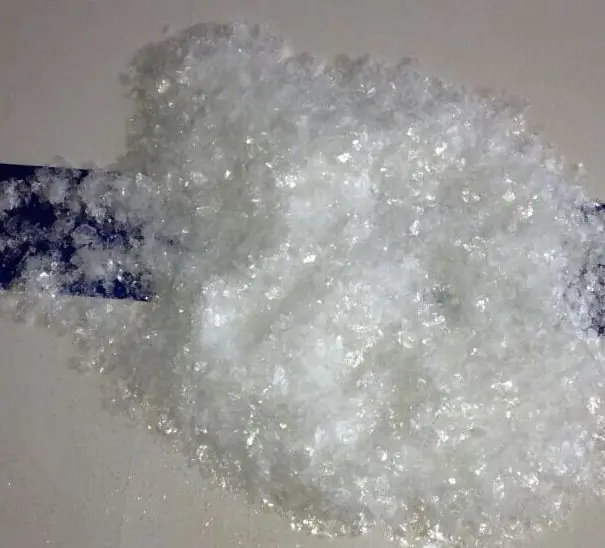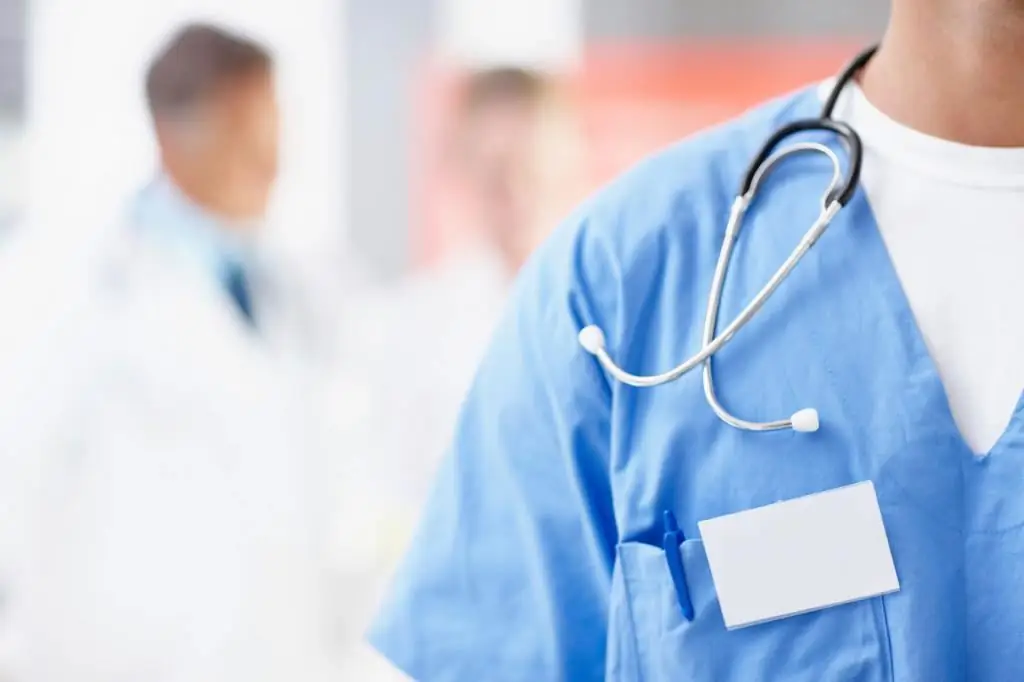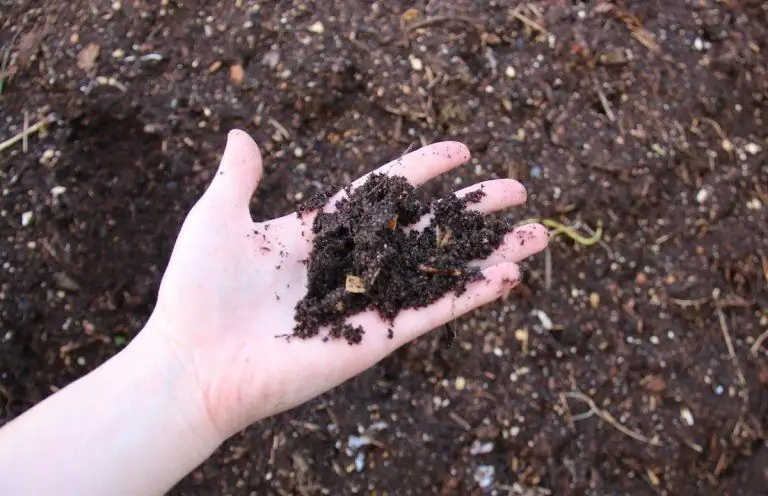- Author Curtis Blomfield [email protected].
- Public 2023-12-16 20:44.
- Last modified 2025-01-23 17:01.
Small sachets of boric acid for only 50 rubles were seen by many in the pharmacy. But what can they be used for? Basically, this substance is used as an antiseptic. But besides this, boric acid can serve in many other areas: from fire fighting to the destruction of pests in homes.
What is this
Boric acid, or, otherwise, orthoboric acid, is a substance with weak acidic properties. That is, unlike sulfuric acid, it is impossible to get burned by only slightly touching it. But that doesn't mean it's safe.

Outwardly, it is a white crystalline powder, which has no taste and smell. Easily dissolves in water, but in warm it happens faster. When heated slowly, it turns into metaboric acid, and when heated quickly, into boron oxide.
It occurs naturally as the mineral Sassolina, which is mined in lagoons of volcanic origin and near extinct volcanoes. But its reserves in nature are quite limited. And therefore, the overwhelming amount of boric acid is produced artificially, by mixing tetraboratesodium with hydrochloric acid.
Issue form
In pharmacies, boric acid can be purchased in three forms:
- crystalline powder;
- ointment;
- alcoholic solution for external use.

In the form of a powder, boric acid is sold in its pure form. But in this form, it cannot be applied to the skin, it is necessary to prepare a solution, the proportions of which depend on the scope of application. In the case of an alcohol solution, there is only 0.3 g of boric acid, and the rest is ethyl alcohol and auxiliary substances. That is, it is a ready-to-use solution. The ointment contains 5% acid and petroleum jelly, suitable for rubbing into the skin.
In medicine
No wonder boric acid is sold in pharmacies. It is actively used as an antiseptic, antiparasitic and antifungal agent. Therefore, boric acid powder, boric ointment or alcohol solution can be used as a fight against the following diseases:
- pediculosis;
- fungal skin diseases;
- otitis media;
- skin eczema;
- pyoderma,
- diaper rash.
For the treatment of otitis media, an alcohol solution is needed, as it will create additional heat.

Applying boric acid to the ear looks like this:
- Lie on one side, put 3 drops from the pipette into the sore ear.
- Lie like this for about 15 minutes.
- Cover the affected ear with cotton wool.
- Repeat the procedure 4 times a day.
Ifacid is used to treat conjunctivitis, then it should be exclusively an aqueous solution of boric acid in a ratio of 2 parts of powder to 100 parts of water. This solution should be used to wash the sore eye.
Boric ointment is used to treat head lice. You need to apply it to dry, dirty hair and cover it with a plastic bag. After 2 hours, comb out the ointment along with dead parasites and their nits. Yes, there are many more effective and safer products now, but none of them can compare with boric ointment for the price.
You can apply it exclusively externally, without getting on the mucous membranes. And for pregnant women and children under 3 years old, boric acid is contraindicated even for external use. Since the harm that it can cause to the formation of the fetus and the reproductive system has been proven. And also for people with kidney disease, boric acid is contraindicated due to its long excretion from the body.

Today it is worth thinking about the ratio of the harm of acid to the body and its benefits. For example, in order for boric acid to work, its minimum concentration of 2% is required, but potassium permanganate and Furacilin need only 0.01%, but the most modern antiseptic is chlorhexidine - only 0.005% is enough to be effective.
In the chemical industry
There is also technical boric acid. It finds wide application in chemical laboratories. On its basis, combined preparations are often made. It is involved in the process of nickel plating of metals. BUTit is also used as part of buffer solutions. Here are some more applications for it in the chemical industry:
- making paints and glazes for ceramics;
- metallurgy;
- electroplating;
- paraffin making;
- nuclear energy;
- woodworking compounds;
- production of surfactants.
Boric acid is also used in the manufacture of glass, fiberglass and ceramics on an industrial scale. Thanks to it, the glass becomes stronger and does not delaminate, which occurs due to a decrease in the melting point.
Flame retardant
Relatively recently, the fire-retardant properties of boric acid and sodium tetraborate, or simply borax, were discovered. With the help of solutions based on these substances, it is much easier to extinguish fires.

This happens because the solution of boric acid or borax prevents oxygen from reaching the place of combustion, which negates the fire. But even if combustion continues to occur, much less harmful combustible fumes are released due to storm or acid, but only carbon. That is why these substances are actively used in professional firefighting.
Food industry
Here it is known as food additive E284. Used as a preservative for perishable animal products or fermented products such as beer or kvass. But in Russia, it is prohibited for use in food, as it is officially recognized as toxic to the human body. But they continue to use it externally in Russia.

But in the EU countries, canning powders are freely sold, which, along with spices, also include boric acid. Despite this, it is worth remembering that the drug, when taken orally, accumulates in the body and in large quantities can cause difficulty in the work of the kidneys of the heart and abnormal development of the fetus in pregnant women.
Ingestion
You must strictly follow the instructions for boric acid. Neglecting this is fraught with dangerous consequences for both he alth and life in general. And this despite the fact that boric acid is not a highly toxic substance.
It is impossible to allow prolonged contact with it, and even more so getting inside in its pure form. When ingested in large quantities or on the mucous membrane, poisoning with boric acid occurs. It will result in the following manifestations:
- vomit;
- diarrhea;
- convulsions;
- ulcers.
When ingested, quantities from 2 to 20 g can even be fatal. Such a large fluctuation in the amount of the lethal dose is associated with the individual characteristics of the organism, such as age, weight and he alth of the person.
In the fight against cockroaches
The use of boric acid from cockroaches and ants is not unknown. This is perhaps the most famous folk insecticide. To make it at home, you need to prepare a bait for insects so that they eat it. Although for a person this acidIt has no smell and taste, it repels insects with a smell. Therefore, it needs to be masked. The recipe for boric acid as a homemade insecticide looks like this:
- attractive substance (egg, honey or sugar) - 2 spoons;
- a sachet of boric acid;
- 1 tbsp spoons of flour;
- a couple of drops of oil (to get rid of the smell of boron).
You need to mix these ingredients and roll lumps from the resulting dough, and then spread them out in secluded places in the apartment. Insects will eat them and receive a lethal dose of boric acid. It affects the nervous system of insects, making their continued existence impossible.

If you call the sanitary and epidemiological station, then for free it will treat the room with nothing more than a solution of boric acid. More modern and expensive insecticides are already used by private companies. The undoubted advantage of this method is the low cost of boric acid and its easy availability. But, unfortunately, many modern insects have already developed a strong immunity to this remedy.
Agricultural applications
Another area of its application is the care of vegetables in the garden. One of the most favorite vegetable crops to grow in Russia are cucumbers and tomatoes. For the sake of their exquisite taste, gardeners endure all the difficulties associated with growing them.

This is the construction of greenhouses, and tying up, and careful adherence to the irrigation regime, and, of course, top dressing. That's just asfertilizers and use boric acid. In addition, it will fit as a fertilizer for the following horticultural crops:
- potato;
- beets;
- strawberry;
- grapes;
- pears;
- apples.
The fact is that boron is an important trace element for their growth, which helps to absorb other important macro- and micronutrients.
And also it is able to fight microorganisms that harm plants. Therefore, by spraying fruits and vegetables with boric acid, you can kill two birds with one stone.
To prepare fertilizer from this acid, you need to make a solution by diluting half a teaspoon in a glass of warm water. And then you can already fertilize in two ways: by watering with a solution directly under the root or by spraying. It is possible to fertilize the soil itself with this solution, the concentration of boron in the soil makes it more fertile. But do not be too zealous, because an excess of boron in the soil is harmful to plants.
Cosmetics
In cosmetics such as baby powder, creams and soaps, boric acid acts as an emulsifier. That is, it helps to achieve a homogeneous consistency when mixing two substances that do not initially mix with each other, such as water and oil.

Those who are prone to allergic reactions, as well as children and pregnant women, should be wary of cosmetics with boric acid in their composition. It is easy to identify it in the composition - it will be listed under one of these names:
- boric acid;
- orthoboric acid;
- boric acid;
- acidum boricum;
- E-284.
In addition to the emulsifying properties of boric acid, its antiseptic qualities are also used here. That is, it also acts as a preservative for perishable components of natural origin in cosmetics.






